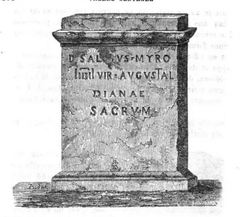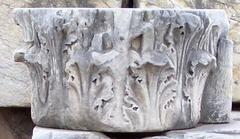Roman Theatre of Aosta: Visiting Hours, Tickets, and Historical Sites Guide
Date: 03/07/2025
Introduction
The Roman Theatre of Aosta, situated in the heart of Italy’s Aosta Valley, is a striking testament to Roman ingenuity, urban planning, and cultural vitality. Built shortly after the city’s founding in 25 B.C. as Augusta Praetoria Salassorum, the theatre not only embodied the Empire’s architectural prowess but also served as a hub for entertainment and civic life. Today, as both an archaeological treasure and a vibrant cultural venue, the theatre bridges the ancient and modern worlds through guided tours, special events, and ongoing preservation efforts (guidaturisticaosta.it, LoveVDA, Italia.it).
This comprehensive guide covers everything you need to plan your visit: detailed historical context, visiting hours, ticketing, accessibility, travel tips, and highlights of nearby attractions.
Table of Contents
- Discover the Roman Theatre of Aosta
- Roman Foundations and Urban Planning
- Construction and Architectural Features
- Social and Cultural Role
- Medieval Decline and Rediscovery
- Modern Preservation and Visitor Information
- FAQs
- Monumental Façade and Structural Layout
- Cavea, Orchestra, and Stage
- Roofing and Connectivity
- Decorative Elements and Materials
- Modern Restoration Efforts
- Nearby Attractions and Suggested Itineraries
- Visitor Tips
- Contact Information
- References
Discover the Roman Theatre of Aosta
The Roman Theatre of Aosta is one of the Alpine region’s most remarkable archaeological sites. Its monumental southern façade, rising to 22 meters, and well-preserved seating area, or cavea, offer a unique window into the grandeur of Roman public architecture. The theatre, once central to the city’s civic and social life, continues to thrive as a setting for concerts, performances, and community events (guidaturisticaosta.it).
Roman Foundations and Urban Planning
Aosta was founded in 25 B.C. as a Roman colony after the defeat of the indigenous Salassi tribe. The city’s orthogonal grid layout reflected Roman ideals of order and integration, with the forum at its heart and the theatre annexed to the city’s defensive walls near the Porta Praetoria (guidaturisticaosta.it). This urban arrangement underscored Aosta’s strategic and cultural importance as a gateway to the Alps.
Construction and Architectural Features
The theatre, constructed in the late Augustan period, spans approximately 81 by 64 meters and originally seated between 3,000 and 4,000 spectators. Its iconic façade features four levels—ground-floor arches and three tiers of windows—combining both structural stability and visual impact (Tascapan). The cavea, built into a natural slope, maximized sightlines and acoustics, while the orchestra and stage were adorned with Corinthian columns and marble inlays (Italia.it).
Social and Cultural Role
More than a venue for entertainment, the theatre was a space for public meetings, ceremonies, and social rituals. Its proximity to the amphitheatre and other monumental Roman structures in Aosta highlights its centrality to the city’s identity and cultural life (guidaturisticaosta.it).
Medieval Decline and Rediscovery
After the Western Roman Empire’s fall, the theatre fell into disuse. Its stones were repurposed for medieval construction, though the southern façade and parts of the cavea survived as part of the city’s defenses (LoveVDA). Archaeological interest revived in the 19th century, with systematic restoration and excavations revealing the theatre’s original scale and splendor (Tascapan).
Modern Preservation and Visitor Information
Ongoing conservation efforts have made the Roman Theatre one of the best-preserved in the Alps. Restoration since the late 20th century has included stonework repair and the use of advanced technologies like 3D laser scanning (Valle d’Aosta Heritage, Laser Scanning Forum). As of July 2025, the site is closed for major redevelopment, expected to reopen in autumn 2025 (LoveVDA).
Visiting Hours and Tickets
- Regular hours (when open):
- April–September: 9:00 AM–7:00 PM
- October–March: 10:00 AM–1:00 PM, 2:00 PM–5:00 PM
- Closed December 25 and January 1
- Ticket Prices:
- Full price: €5–7 (subject to change)
- Reduced rates and free entry for children, students, seniors, and disabled visitors
- Combined tickets available for multiple Roman sites (LoveVDA, Guida Turistica Aosta)
- Guided Tours: Offered in multiple languages, highly recommended for a deeper understanding (guidaturisticaosta.it).
Accessibility
The site is equipped with ramps and paved pathways, ensuring barrier-free access for wheelchair users and visitors with reduced mobility (LoveVDA).
Getting There and Nearby Attractions
Located within Aosta’s walkable historic center, the theatre is easily accessible by foot, public transport, or car (parking available nearby). Combine your visit with the Porta Praetoria, Arch of Augustus, Cryptoporticus, and the Aosta Cathedral for a full historical experience (Italia.it).
Special Events
The theatre hosts open-air concerts, summer festivals, and the city’s Christmas market. Check the official events calendar for current programming (L’Atelier du Temps).
FAQs
Q: What are the Roman Theatre of Aosta’s visiting hours?
A: Generally 9:00 AM–7:00 PM (summer); 10:00 AM–5:00 PM (winter), but check the official site for updates during restoration.
Q: How much do tickets cost?
A: €5–7 for adults; discounts available; combined tickets cover multiple sites.
Q: Is the theatre accessible?
A: Yes, with ramps, paved paths, and accessible restrooms.
Q: Are pets allowed?
A: Small pets are permitted if carried or in a pet carrier.
Q: Are guided tours available?
A: Yes, in several languages; advance booking is recommended.
Monumental Façade and Structural Layout
The theatre’s southern façade, at 22 meters tall and featuring four levels, remains a highlight of Aosta’s skyline (Tascapan). Entrance arches and rows of windows create a rhythmic visual effect while supporting structural loads. The theatre’s rectangular plan and integration into the city wall showcase Roman urban sophistication (Italia.it).
Cavea, Orchestra, and Stage
The semicircular cavea, divided into three tiers, provided ample seating for up to 4,000 spectators. The orchestra was reserved for dignitaries and adorned with mosaics and statues. The stage was backed by a richly decorated wall with Corinthian columns, niches, and marble inlays (LoveVDA).
Roofing and Connectivity
While most Roman theatres were open-air, evidence suggests Aosta’s may have featured a partial roof for acoustic and weather protection. A portico likely linked the theatre to the nearby amphitheatre, facilitating movement between venues (Italia.it).
Decorative Elements and Materials
Excavations have revealed decorative marble, Corinthian columns, and mosaic fragments, highlighting the theatre’s opulence and Augusta Praetoria’s prosperity (Tascapan).
Modern Restoration Efforts
Restoration from the late 1980s onward has stabilized the structure and improved visitor access (Valle d’Aosta Heritage). As of 2025, a major redevelopment aims to enhance accessibility, visitor experience, and integration with nearby sites (LoveVDA).
Nearby Attractions and Suggested Itineraries
- Porta Praetoria: The city’s original Roman gate
- Arch of Augustus: Celebrating Roman victory
- Cryptoporticus: Subterranean Roman gallery
- Aosta Cathedral: Medieval church with Romanesque frescoes
- Regional Archaeological Museum: Roman and medieval artifacts
A 4 km walking itinerary allows you to experience all major sites in half a day (LoveVDA).
Visitor Tips
- Wear comfortable shoes for uneven surfaces.
- Dress in layers due to Alpine weather.
- Official languages are Italian and French; English is widely understood at tourist sites.
- Ample parking is available near the train station and city center (Live in Italy Mag).
- Sample local cuisine at nearby cafés.
- Download the Audiala app for interactive guides, maps, and updates.
Contact Information
- Regional Tourist Office:
Phone: (+39) 0165.40532
Email: [email protected]
(LoveVDA)
Check the official tourism website for the most current updates.
Conclusion
The Roman Theatre of Aosta is not just an archaeological marvel but a living monument—uniting ancient heritage with the dynamic cultural spirit of Aosta. With thoughtful restoration, accessibility, and vibrant programming, it stands ready to enchant visitors anew when it reopens in autumn 2025. Download the Audiala app for enhanced navigation and event updates, and follow official channels to make your journey to Aosta seamless and unforgettable.
References
- Roman Theatre of Aosta: History, Visiting Hours, Tickets & Visitor Guide
- Roman Theatre of Aosta: Visiting Hours, Tickets, and Historical Insights
- The Roman Theatre of Aosta: Visiting Hours, Tickets, and Cultural Significance of Aosta Historical Sites
- Roman Theatre of Aosta Visiting Hours, Tickets, and Essential Visitor Guide
- Italia.it, Roman Theatre of Aosta
- LiveTheWorld, Roman Theatre of Aosta
- L’Atelier du Temps, Summer 2025 Events in Aosta Valley
- Guida Turistica Aosta, Roman Theatre Visitor Information
- Italia.it, Roman Ruins in Aosta
- Love VDA, Roman Theatre Restoration and Visitor Info

